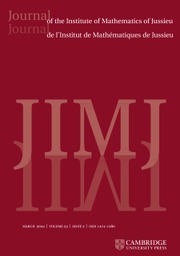No CrossRef data available.
Article contents
INTEGRABLE MODULES OVER QUANTUM SYMMETRIC PAIR COIDEAL SUBALGEBRAS
Part of:
Lie algebras and Lie superalgebras
Published online by Cambridge University Press: 05 June 2025
Abstract
We introduce the notion of integrable modules over  $\imath $quantum groups (a.k.a. quantum symmetric pair coideal subalgebras). After determining a presentation of such modules, we prove that each integrable module over a quantum group is integrable when restricted to an
$\imath $quantum groups (a.k.a. quantum symmetric pair coideal subalgebras). After determining a presentation of such modules, we prove that each integrable module over a quantum group is integrable when restricted to an  $\imath $quantum group. As an application, we show that the space of matrix coefficients of all simple integrable modules over an
$\imath $quantum group. As an application, we show that the space of matrix coefficients of all simple integrable modules over an  $\imath $quantum group of finite type with specific parameters coincides with Bao-Song’s coordinate ring of the
$\imath $quantum group of finite type with specific parameters coincides with Bao-Song’s coordinate ring of the  $\imath $quantum group.
$\imath $quantum group.
MSC classification
Information
- Type
- Research Article
- Information
- Journal of the Institute of Mathematics of Jussieu , Volume 24 , Issue 6 , November 2025 , pp. 2257 - 2282
- Copyright
- © The Author(s), 2025. Published by Cambridge University Press
References
Bao, H and Song, J (2022) Symmetric subgroup schemes, Frobenius splittings, and quantum symmetric pairs. arXiv preprint 2212.13426.Google Scholar
Bao, H and Wang, W (2018) Canonical bases arising from quantum symmetric pairs. Invent. Math. 213(3), 1099–1177.CrossRefGoogle Scholar
Bao, H and Wang, W (2021) Canonical bases arising from quantum symmetric pairs of Kac-Moody type. Compos. Math. 157(7), 1507–1537.CrossRefGoogle Scholar
Dijkhuizen, MS (1996) Some remarks on the construction of quantum symmetric spaces, Representations of Lie groups, Lie algebras and their quantum analogues. Acta Appl. Math. 44(1–2), 59–80.CrossRefGoogle Scholar
Drinfeld, VG (1985) Hopf algebras and the quantum Yang-Baxter equation. Dokl. Akad. Nauk SSSR 283(5), 1060–1064.Google Scholar
Gavrilik, AM and Klimyk, AU (1991)
 $q$
-deformed orthogonal and pseudo-orthogonal algebras and their representations. Lett. Math. Phys. 21(3), 215–220.CrossRefGoogle Scholar
$q$
-deformed orthogonal and pseudo-orthogonal algebras and their representations. Lett. Math. Phys. 21(3), 215–220.CrossRefGoogle Scholar
Iorgov, N and Klimyk, AU (2005) Classification theorem on irreducible representations of the q-deformed algebra
 ${U}_q^{\prime}\left(\mathfrak{s}{\mathfrak{o}}_{\mathfrak{n}}\right)$
. Int. J. Math. Math. Sci. 2, 225–262.CrossRefGoogle Scholar
${U}_q^{\prime}\left(\mathfrak{s}{\mathfrak{o}}_{\mathfrak{n}}\right)$
. Int. J. Math. Math. Sci. 2, 225–262.CrossRefGoogle Scholar
Ito, T and Terwilliger, P (2010) The augmented tridiagonal algebra. Kyushu J. Math. 64(1), 81–144.CrossRefGoogle Scholar
Jimbo, M (1985) A
 $q$
-difference analogue of
$q$
-difference analogue of
 $U\left(\mathfrak{g}\right)$
and the Yang-Baxter equation. Lett. Math. Phys. 10(1), 63–69.CrossRefGoogle Scholar
$U\left(\mathfrak{g}\right)$
and the Yang-Baxter equation. Lett. Math. Phys. 10(1), 63–69.CrossRefGoogle Scholar
Kashiwara, M (1993) Global crystal bases of quantum groups. Duke Math. J. 69(2), 455–485.CrossRefGoogle Scholar
Kolb, S and Stephens, J (2024) Representation theory of very non-standard quantum
 $\mathfrak{so}\left(2N-1\right)$
. arXiv preprint 2407.15538.Google Scholar
$\mathfrak{so}\left(2N-1\right)$
. arXiv preprint 2407.15538.Google Scholar
Letzter, G (1999) Symmetric pairs for quantized enveloping algebras. J. Algebra 220(2), 729–767.CrossRefGoogle Scholar
Letzter, G (2019) Cartan subalgebras for quantum symmetric pair coideals. Represent. Theory 23, 88–153.CrossRefGoogle Scholar
Lusztig, G (1992) Canonical bases in tensor products. Proc. Nat. Acad. Sci. U.S.A. 89(17), 8177–8179.CrossRefGoogle ScholarPubMed
Lusztig, G (2010)
Introduction to Quantum Groups. Reprint of the 1994 edition. Modern Birkhäuser Classics. New York: Birkhäuser/Springer.Google Scholar
Molev, AI (2006) Representations of the twisted quantized enveloping algebra of type
 ${C}_n$
. Mosc. Math. J. 6(3), 531–551, 588.CrossRefGoogle Scholar
${C}_n$
. Mosc. Math. J. 6(3), 531–551, 588.CrossRefGoogle Scholar
Noumi, M (1996) Macdonald’s symmetric polynomials as zonal spherical functions on some quantum homogeneous spaces. Adv. Math. 123(1), 16–77.CrossRefGoogle Scholar
Noumi, M and Sugitani, T (1995) Quantum symmetric spaces and related
 $q$
-orthogonal polynomials. In Group Theoretical Methods in Physics (Toyonaka, 1994). River Edge, NJ: World Scientific Publishing Co., Inc, 28–40.Google Scholar
$q$
-orthogonal polynomials. In Group Theoretical Methods in Physics (Toyonaka, 1994). River Edge, NJ: World Scientific Publishing Co., Inc, 28–40.Google Scholar
Procesi, C (2007) Lie Groups. An Approach Through Invariants and Representations. New York: Universitext, Springer.Google Scholar
Regelskis, V and Vlaar, B (2020) Quasitriangular coideal subalgebras of
 ${U}_q\left(\mathfrak{g}\right)$
in terms of generalized Satake diagrams. Bull. Lond. Math. Soc. 52(4), 693–715.CrossRefGoogle Scholar
${U}_q\left(\mathfrak{g}\right)$
in terms of generalized Satake diagrams. Bull. Lond. Math. Soc. 52(4), 693–715.CrossRefGoogle Scholar
Watanabe, H (2020) Crystal basis theory for a quantum symmetric pair. Int. Math. Res. Not. IMRN 22, 8292–8352.Google Scholar
Watanabe, H (2021) Classical weight modules over quantum groups. J. Algebra 578, 241–302.CrossRefGoogle Scholar
Watanabe, H (2023) Based modules over the quantum group of type AI. Math. Z. 303(2), Paper No. 43, 73 pp.CrossRefGoogle Scholar
Watanabe, H (2023) Stability of canonical bases of irreducible finite type of real rank one. Represent. Theory 27, 1–29.CrossRefGoogle Scholar
Watanabe, H (2024) Stability of canonical bases of locally finite type. In Transformation Groups, https://doi.org/10.1007/s00031-024-09876-x.CrossRefGoogle Scholar
Wenzl, H (2020) On representations of
 ${U}_q^{\prime }{\mathfrak{so}}_n$
. Trans. Amer. Math. Soc. 373(5), 3295–3322.CrossRefGoogle Scholar
${U}_q^{\prime }{\mathfrak{so}}_n$
. Trans. Amer. Math. Soc. 373(5), 3295–3322.CrossRefGoogle Scholar


